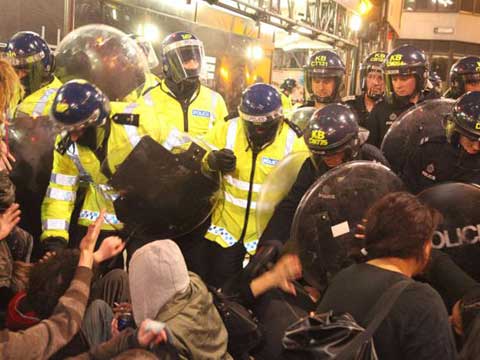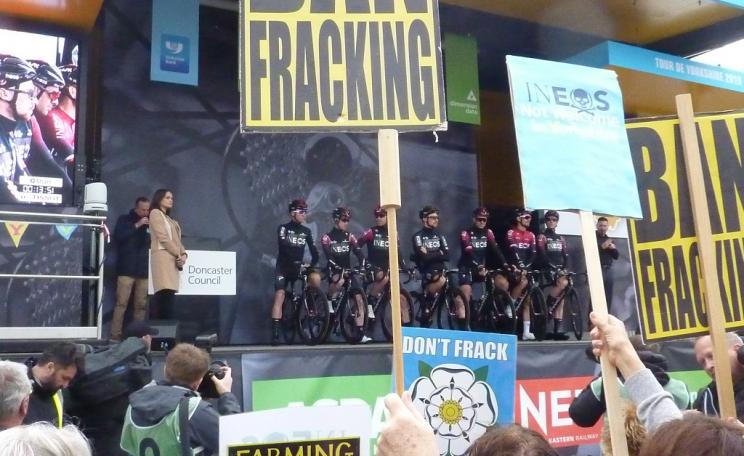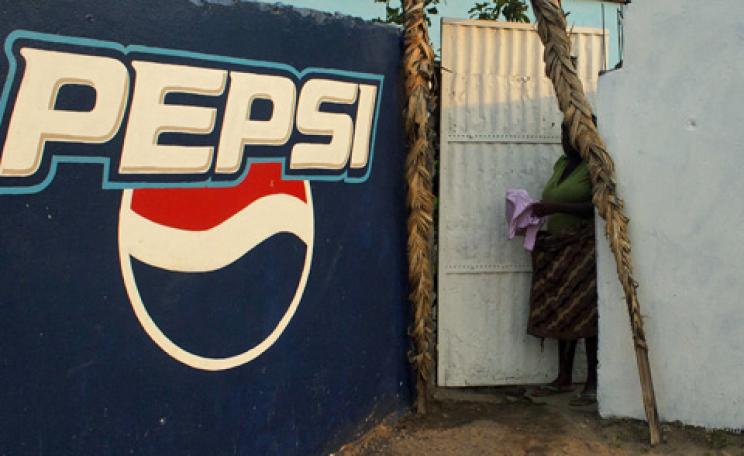The 12 foot structure appears to defy gravity and conventional building rules. It's made of logs placed at 45 degree angles held together with rope and has an Alice-In-Wonderland shrink-me size door only the lithe could squeeze through by lying flat to the ground and wiggling in an inch at a time.
 This is The Donkey. And no it's not an obstacle at a children's play park but one of the many lock-on structures including tree houses (such as the one pictured left), trigloos (an igloo suspended in the air), towers and overhead rope walk ways built by activists at the Defend Huntington Lane camp in Little Wrenlock, Shropshire. When eviction day comes (they were served papers in July but other than a few failed attempts to begin work the camp has been left alone), these structures and the activists inside them will stand between the pristine countryside and an open cast mine.
This is The Donkey. And no it's not an obstacle at a children's play park but one of the many lock-on structures including tree houses (such as the one pictured left), trigloos (an igloo suspended in the air), towers and overhead rope walk ways built by activists at the Defend Huntington Lane camp in Little Wrenlock, Shropshire. When eviction day comes (they were served papers in July but other than a few failed attempts to begin work the camp has been left alone), these structures and the activists inside them will stand between the pristine countryside and an open cast mine.
The site was set up in March 2010 after UK Coal was granted permission in October 2009 to extract 900,000 tonnes of poor grade coal from a 230 acre area including swathes of ancient woodland in the Shropshire Hills Area Of Outstanding Natural Beauty at the foot of The Wrekin, a 1335 metre hill overlooking the area said to have inspired Tolkien's Middle Earth in The Lord Of The Rings.
A core group of 12 man the site (even when temperatures dropped to minus 14) but numbers fluctuate with events and celebrations attracting crowds into the hundreds. Visitors are welcome and the camp has an open door policy. Besides the site the group have undertaken stunts such as sailing a flotilla down the River Severn to raise awareness and conducting a street re-naming ceremony where New Works Lane was rechristened Methane Lane and Mill Bank became Lung Disease Lane. A few weeks ago they produced a satirical Visit The Wrekin postcard that features photographs of the former landscape and the current works on the open cast site.
Blighted landscape
The mine will not only blight the vista with a vast open black sore and puncture the peace with the relentless growl of machinery but will release over 2,430,000 tonnes of CO2; destroy ancient sites of pagan worship; cut down scores of mature trees; butt up to locals back gardens and, perhaps most worryingly for those close to it, spew out coal dust known to be seriously hazardous to human health throughout it's scheduled three years of operation.
Communities in close proximity to open casts - and so are exposed to high levels of pollutants such as particulate matter (coal dust) and water pollution - are at risk of lung, heart and kidney diseases, yet there is little official research in this area.
Huntington Lane locals had to coerce Telford and Wrekin Council and the Primary Healthcare Trust for a Health Impact Assessment (HIA) to be carried out. Published two years ago it has never been made public and only UK Coal, Telford and Wrekin council and Pat Judson, the spokesperson for Friends of the Wrekin who led the fight against the open cast in the campaigns early days, have copies.
Judson believes this is an attempt by the council to 'bury the reports findings' and consequently he's publicised its content through the local media and the Friends Of The Wrekin website. He says the report is full of damning evidence but conclusions of particular concern are that the mine will mean a substantial increase in the amount of poly aromatic hydrocarbons (DNA damaging chemicals which have a carcinogenic effect) in the atmosphere in the vicinity of two local primary schools and three residential areas.
He also notes ‘funny business' such as the reports failure to include a gypsy site, the ‘accidental' removal of the professional title from the Doctor who gives evidence about the health implications of open casts, and that just weeks before the public enquiry he received the HIA as a box of papers but UK Coal and the council received it on disk. 'I'm retired so I had the time to dedicate to this fight,' he says. 'But it's cost me my health and nearly my marriage. That's what companies like UK Coal rely on - the public not having the time, energy or expertise to fight them.'
The UK's coal addiction
Unlike in Scotland and Wales where new regulations state open cast boundaries must not fall within a 500metre buffer zone of public buildings such as homes and schools, there is no such regulation in England.
In February a bill to instigate a similar buffer zone from Conservative MP Andrew Bridgen, whose Leicestershire constituents are currently fighting opencast applications, had its second reading. Action groups such as Defend Huntington Lane are calling for people to ask local MP's to support the bill and raise awareness about the surreptitious revival of open cast mining in the UK, a practice many believe had been resigned to the 20th century archives of dirty, inefficient, carbon-intensive energy production as it emits more CO2 than any other fossil fuel.
In January Minorca Opencast Protest Group (MOPG) revealed there are at least 29 sites in England that were either operational, had received planning permission or are in the planning process. They identified another 34 sites across Cumbria, Nottinghamshire, Shropshire, Yorkshire, Derbyshire and other counties that could be developed.
For Annie, a regular at the Huntington Lane protest site, it's this stirring of the open cast beast that inspires her to keep fighting what is now a lost battle. Work has already begun to prepare the mine for extraction and despite local objection a £500,000 community fund has been set up by UK Coal to be administered by the Huntington Lane Surface Mine Community Liaison Committee made up of community representatives.
'They chose money over the health and well being of the community,' says Annie. 'The mines already happening but we want to leave a legacy to communities facing opencasts of how to fight them by providing information on what meetings to attend, what questions to ask, what to look for in plans to identify breaches and what impact assessments to demand.'
Taking action
 Although the protest site is just a year old the fight against the open cast has gone on for six and according to activists involves a myriad of spin and policy breaches from UK Coal, local councillors and the Liaison Committee tasked with mediating between all interested parties. 'The trouble with that trio,' says Judson, ‘is it's hard to tell where one starts and the other ends. When you look at who is involved there are major conflicts of interest.'
Although the protest site is just a year old the fight against the open cast has gone on for six and according to activists involves a myriad of spin and policy breaches from UK Coal, local councillors and the Liaison Committee tasked with mediating between all interested parties. 'The trouble with that trio,' says Judson, ‘is it's hard to tell where one starts and the other ends. When you look at who is involved there are major conflicts of interest.'
While sitting around an open fire the activists rely tale after tale of bureaucratic misdemeanours. They say that during the planning application process UK Coal argued old mining tunnels under the site made it unsafe for public use yet after planning permission was granted they used heavy industrial machinery on the same land they deemed too weak for dog walkers to safely cross.
UK Coal also pledged not to fell trees older than 20 years yet close to the protest site an 80 year-old Oak lies dismembered, as do scores of other mature trees.
Just last month the energy company served an 8 week eviction notice on long-term tenants in housing close to the Huntington Lane site. Activists believe a couple were targeted after they'd supported the protest camp by charging their batteries and supplying them with water. In the case of a house-bound 86 year-old local who's house backs directly onto the mine UK Coal have refused to buy her property or give her compensation despite the view she once enjoyed now an apocalyptic black mound.
The question of where the coal will be transported to is another thorny issue. The 2007 Sustainable Communities Act stipulates coal should not be transported more than 30 miles from source to usage. The nearest power station is Britain's ‘dirtiest' station Ironbridge (also known as Buildwas) but it's understood by locals that due to the poor quality of the coal even they don't want it.
'It wouldn't be quite so bad if the coal was useful,' says a local activist who wished not to be named. 'But all this heartache and destruction for coal so crap nobody wants it is just ridiculous.'
Further information:
Sarah Bentley is a freelance journalist
| READ MORE... | |
 |
COMMENT Climate activists need to protect their right to protest Following the High Court judge ruling that police 'kettling' tactics at the G20 protests were illegal, Climate Camp legal advisor Frances Wright argues that protestors need to be more aware than ever of their rights |
 |
INVESTIGATION Activist families: the parents and children protesting against climate change Can families play a frontline role in the fight against climate change? The Ecologist meets the parent-child activists who believe they can |
 |
INVESTIGATION Bexhill bypass puts road building back in the spotlight Opponents say the controversial bypass will damage ancient woodlands, disturb wetland birds and impact on protected areas - and it's just one of 22 similar schemes currently awaiting approval. Jan Goodey investigates |
 |
INVESTIGATION UK shale gas boom 'may be dirtier than coal' Despite outrage in the US over ‘fracturing’ techniques used to extract shale gas and new evidence its greenhouse gas footprint may be higher than that of coal, the UK has given the go-ahead to companies here to begin drilling. Tom Levitt reports from the centre of this potential unconventional gas boom near Blackpool |
 |
NEWS End $300 billion subsidies for fossil fuels, says energy watchdog Subsidies for oil, coal and gas sectors were six times higher than those for renewable energy in 2009, the latest International Energy Agency (IEA) assessment has revealed |








